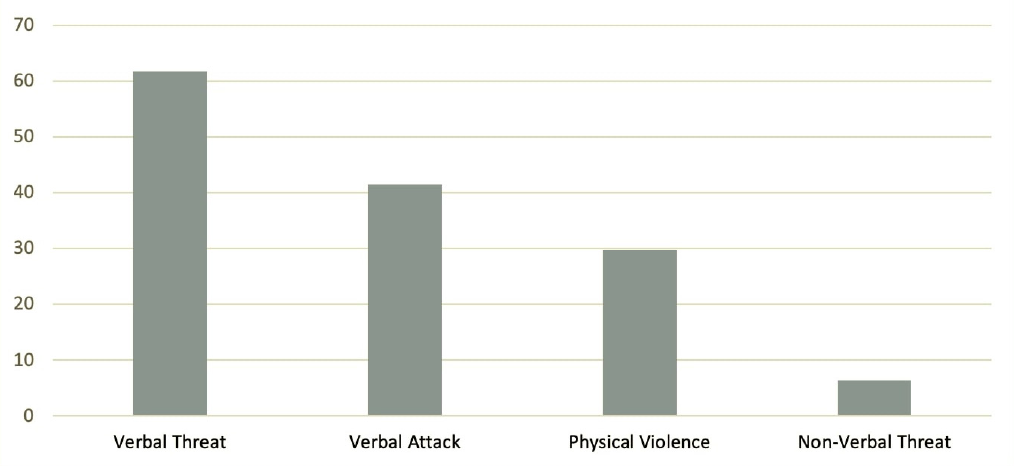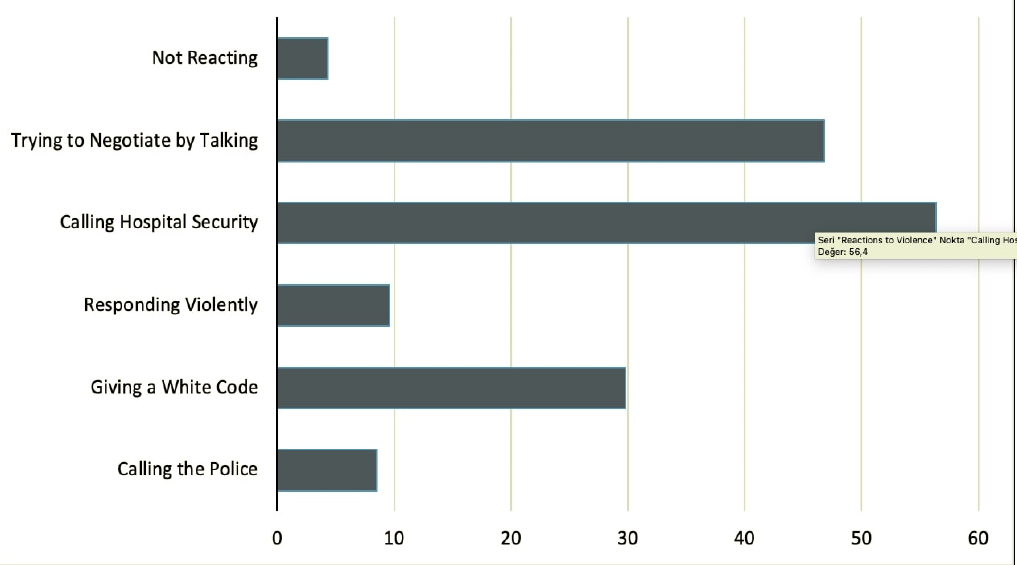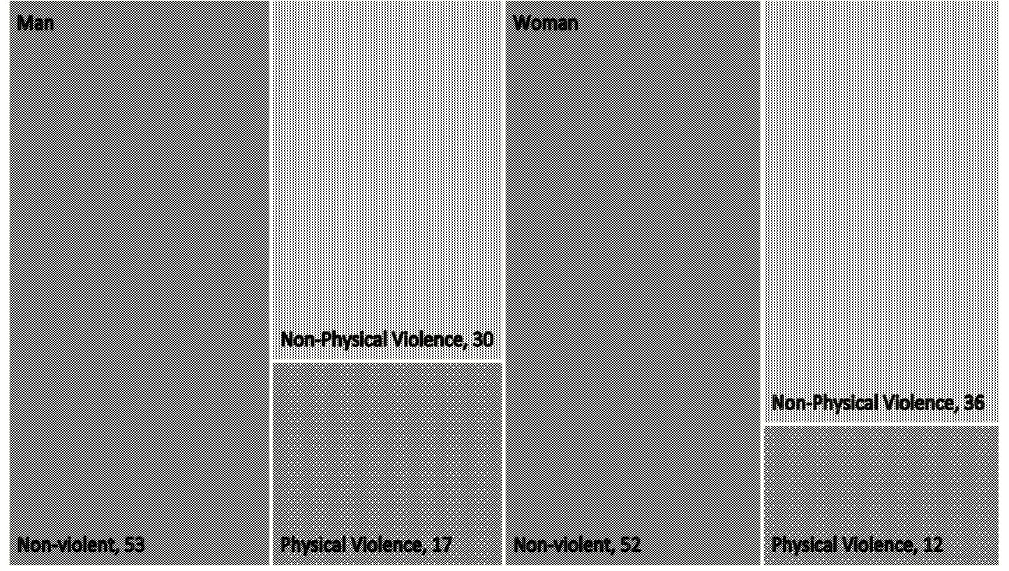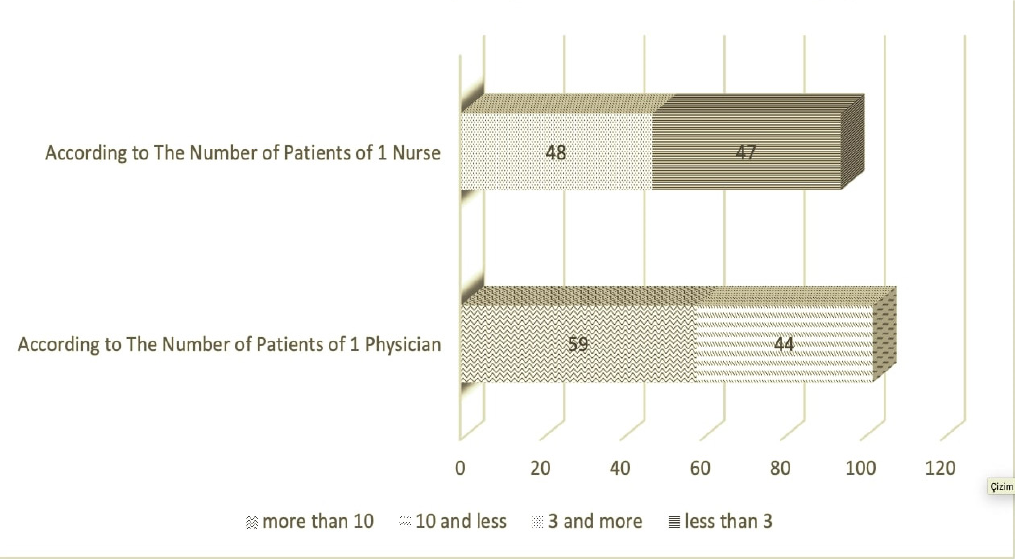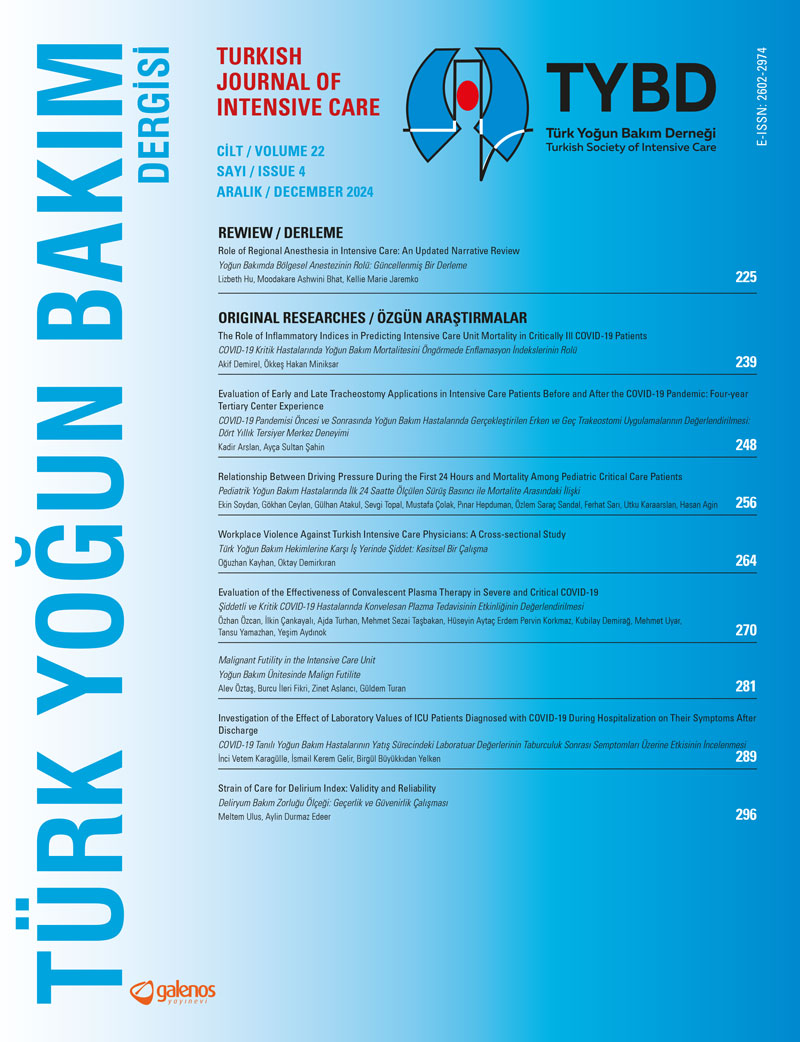Abstract
Objective:
It was aimed to get the experience and opinions of intensive care physicians, who are health professionals who experience violence with increasing frequency.
Materials and Methods:
The questionnaire, consisting of 28 multiple choice and open-ended questions, was answered by intensivists across the country.
Results:
In the online questionnaire study, which was answered by 198 physicians, 44% male and 56% female, it was found that 86% of the physicians experienced violence in the hospital where they worked, and 47% were exposed to violence during their work in the intensive care unit. It was observed that the most common violence was verbal threats with and physical violence. Victims of violence stated that they mostly prefer to call hospital security (56%). It was determined that 65% of the violent incidents experienced were resolved by talking. The common view of the victims of violence and of the vast majority of all physicians was that the measures were insufficient and the violence would recur.
Conclusion:
Violence in health is increasing all over the world and in Turkey. The precautions to be taken should be aimed at the patients and their relatives, as well as the health workers and the health system itself.
Keywords: Intensive care, violance, physician, workplace violance, violance in healthcare
Introduction
Workplace violence is a global problem. It was first defined in 1997 as “incidences in which individuals are abused, threatened or attacked in conditions related to their work, involving an explicit or implicit threat to their safety, well-being and health” (1).
In a year, violence in the health sector increases by up to 62% (2). The incidence of physical violence is 24%, and that of non-physical violence is 43% (2). In Turkey, this rate accounts for approximately half of all health workers (3).
In terms of all sectors, the frequency of violence in the health sector is at the top of the list (4).
Although it is the first possible inference that violence will decrease as countries’ development level increases, the facts may be the opposite (5).
Violence in the workplace can take the form of physical and psychological attacks. It can take the form of assault, harassment, bullying, mobbing, abuse, sexual harassment, racial harassment, and threats. Because physical violence can be defined by everyone, awareness of this issue is high. However, there are many different types of psychological violence, and since awareness of this issue is gradually increasing, incidents of psychological violence are being noticed more and more.
Studies have found that among the risk factors defined for workplace violence, shift workers, younger workers, and those with long working hours per week are more likely to be exposed to any type of violence (2). In a large-scale systematic review, male workers, single workers, physicians, nurses, more experienced workers, and those of white ethnic origin were found to have a higher risk of exposure to violence (2).
The aim of this study was to investigate the history of exposure to violence and thoughts of physicians working in intensive care units.
Materials and Methods
The research, which was planned as a survey study, was conducted by answering an online questionnaire, which was created from 28 multiple choice and open-ended questions, by all intensive care physicians that could be reached across the country. The survey was prepared using Google Forms. The link to the survey was shared in WhatsApp and mail groups, including intensive care physicians from all over Turkey. The study was published on the home page of the Turkish Society of Intensive Care website for 1 week and for 1 month in the announcement section. The questionnaire was kept open for response for a period of 1 month and then closed for response.
Since the study was a survey of physicians, patients were not included in the study and therefore there was no need to obtain patient informed consent. The first 7 were questions inquiring about demographic data. The next 12 were about the physical conditions of the intensive care unit where the physician worked and the number of employees and patients. The last 8 consisted of questions about the characteristics and consequences of the violence.
The study was approved by the İstanbul University-Cerrahpaşa, Cerrahpaşa Faculty of Medicine Ethics Committee (date: 19.09.2018, number: 72109855-604.01.01-60122).
Statistical Analysis
Chi-square analysis was used as the statistical method. The significance level was set as p<0.05. Independent variables, including demographic variables, are shown in frequency tables with numbers and percentages.
Results
Of the 224 intensive care physicians, 198 answered the questionnaire. Of the respondents, 44.4% (n=88) of the respondents were male and 55.6% (n=110) were female. Those who worked in the intensive care unit for 5 years or less were 37.4% (n=74), and those with 6 years or more were 62.6% (n=124). It was determined that the participants mainly worked in universities (41.9% n=83) and training and research hospitals (28% n=59) and mostly from anesthesiology and reanimation as their main branch (82.3% n=163).
It was determined that most of the physicians treated 6-10 patients (47% n=93), while nurses cared for 3 patients (57.1% n=113). According to the results of the study, the relatives of the patients did not participate in the treatment process, and the patient treatment information was mainly given by the intensive care physician every day of the week; it was determined that the nurses did not accompany the physicians while giving information.
85.9% (n=170) of the participants reported seeing violence in the hospital where they worked. The rate of those who were exposed to violence during their work in the intensive care unit was 47% (n=94).
The violence encountered in the intensive care unit was mostly verbal threats [61.7% (n=58)]. It was stated that 41.5% (n=39) experienced verbal attack, 29.8% (n=28) physical violence, and 6.4% (n=6) non-verbal threat (Figure 1). It was observed that violence was mainly applied by relatives of patients (47%).
The reactions of the participants who faced violence are; 8.5% (n=8) called the police, 29.8% (n=28) gave white code, 9.6% (n=9) responded to violence with violence, 56.4% (n=53) called the hospital security, 46.8% (n=44) tried to reach an agreement by talking and 4 participants stated that they did not give any reaction to violence (Figure 2).
It was reported that 65% of the violence cases were resolved by talking, 11.7% complained to the police, 14.9% were prosecuted, and 2.1% were sentenced to prison.
While 97% of those who were exposed to violence thought that efforts to prevent violence in the field of health were insufficient, this rate was 96% among all participants. Among those who were exposed to violence, 84% thought that violence would be repeated was 84%.
Chi-square analysis in independent groups was conducted to determine whether there was a significant relationship between violence and the independent variables asked in the questionnaire. A significant correlation was found only between the type of hospital and the frequency of violence (p=0.009).
Among the respondents, 47% of men and 48% of women were exposed to violence. Although 37% of the men were exposed to violence, 25% were found to have been subjected to physical violence (Figure 3).
Considering the number of intensive care patients, 59% of physicians who treated >10 patients were exposed to violence, whereas 44% of physicians who treated 10 patients experienced violence (Figure 4). While the rate of violence against physicians in intensive care units where a nurse cares for 3 or more patients was 48%, it was 47% for those under 3 (Figure 4).
At the top of the measures demanded to be taken to prevent violence was the enactment of laws specific to violence in the field of health (Table 1).
| Table 1. What measures do you think should be taken to prevent violence in healthcare? [% (n)] | |
|
Enacting laws specific to violence in health |
76% (151) |
|
Increasing prison sentences |
68% (134) |
|
Subjecting attackers to compulsory education programs |
57% (113) |
|
Increasing fines |
55% (108) |
|
Prevention of receiving services from the health institution where the violence took place |
52% (102) |
|
Prohibition of benefiting from the Social Security Institution for a period of time |
35% (69) |
|
Prohibition of benefiting from the Social Security Institution indefinitely |
30% (59) |
Discussion
It is understood from the data obtained in this study that most physicians working in intensive care units are exposed to any type of violence. Almost all of them believe that the measures taken against violence are insufficient. The vast majority demand preventive laws, deterrent penalties, and education programs.
Studies have revealed that violence against healthcare professionals is experienced at varying rates but at high frequencies in all countries worldwide. In a meta-analysis in which 65 studies of 61,800 health workers from 30 countries were evaluated and physical violence was investigated, it was reported that the 1-year frequency of violence was 19% (5). It has been concluded that the rate of violence is 26% in Europe, 24% in the United States, and 21% in Africa, and the frequency of violence increases as the income levels of the countries increase. The highest frequency was observed in nursing homes 30%, followed by tertiary healthcare institutions. It was reported that 1-year violence events were 23% against nurses and 15% against physicians, and the difference was statistically significant. The frequency of violence was found to be higher in urban areas (26%) than in rural areas (6%). What we would probably predict is less violence in health in countries with better socioeconomic status. This meta-analysis, on the other hand, says the opposite. If we assume that the level of development is an indicator of civilization, we can also assume that civilized countries should have fewer violent people, but unfortunately we cannot see this in real life.
After the violence, it is important what attitude the country adopts in accordance with the policies developed against it. It is necessary for health workers to feel safe that the state’s attitude toward violence is clearly revealed by the administrators. A cross-sectional study conducted in Bangladesh reported that 43% of health workers were exposed to any form of violence, and 16% of them experienced physical violence (6). 65% of the victims of violence reported that nothing was done against the violence they experienced, and 44% of the cases in which something was done for violence were inconclusive. In a study conducted among physicians in Italy, the frequency of verbal violence in the last 1 year was reported to be 52% and the frequency of physical violence was 4% (7). 61% of those who were exposed to verbal violence and 22% of those who were exposed to physical violence stated that they did not have any reaction. In our study, it was seen that the prevailing opinion was that the measures taken were very insufficient (96%) and that the perpetrator would use violence again (84%). The high demands of physicians, such as new laws, high penalties, and compulsory education programs, are due to their insecurity in the current situation.
Beyond the acute consequences of violence, victims also experience psychological consequences experienced by the victims. They can be affected in different ways, from depression to post-traumatic stress disorder. A study conducted with family health center workers in Brazil reported that 36% of the victims of violence showed signs of depression and 16% probably had major depression (8). It was stated that as the violence experienced by the victims increased, their depressive symptoms also increased. It would not be wrong to think that a similar situation exists in our country. The quality of life of health workers, who are forced to live under harsh conditions, also decreases as a result of the psychological state of exposure to violence. Job satisfaction decreases, and the desire for job change becomes widespread. The satisfaction of patients, who have to receive service from unhappy and restless health workers, from the health system, which can only be performed with the devotion of employees, is gradually decreasing. Because the doctor he/she went to did not pay as much attention to the patient as he/she wanted due to his/her workload and possible depression, he/she goes to another doctor, then to another doctor, and the health system is thus overwhelmed. This results in increased violence because healthcare workers are overwhelmed by the workload due to busier hospitals and patients who require more attention and time.
The most undesirable and traumatic outcome of violence is the killing of healthcare workers. A study conducted in the United States reported that 61 healthcare workers died due to workplace violence between 2003 and 2016, of which 52% were due to suicide and 34% to murder (9). It has been reported that 28% of the victims were doctors, 21% were nurses, and the rest were other health and safety workers. Regardless of the circumstances, death can affect survivors in a wide variety of ways. The death of a physician as a result of murder not only deeply hurts his/her relatives but also deeply affects all physicians as a professional group. Every physician experiences this trauma within himself/herself, and his/her love and commitment to his/her profession is damaged. Physicians, who are the owners of a profession with high self-sacrifice, come to the point of questioning their own self-sacrifice, lives, and professions as a result of every physician murder, and this even goes to the point of changing professions. Considering the effort and years spent training a physician, the loss is.
In a study conducted in China, 459 files were opened due to violence against healthcare professionals as a result of the scanning of judicial system records between 2013 and 2016 (10). It has been reported that the highest risk rate is in primary healthcare institutions (43%), the most risky department is emergency (51%), physicians are the most risky group (55%, and the most common type of violence is physical 77%). In 1.6% of the cases, the event resulted in death. In our research, the results of violent incidents were questioned, and only 15% of them were brought to the judiciary. Every unpunished crime has a chance of being repeated. The reliability of law is one of the most important elements of a country. A healthcare worker who has been subjected to violence has no other choice but to apply to the judiciary. The state and judicial system will protect the physician.
Unfortunately, the situation in our country- where medicine is the most valued profession- is not different from the rest of the world. In a study conducted in Turkey, 447 healthcare workers were surveyed (11). 37% of the respondents, 37% reported having experienced physical violence during their working life, and 89% had been verbally abused. It was reported that physical violence occurred in 41% of the patients, in 34% of the patients, in midwives, nurses, and emergency medical technicians who answered the questionnaire, and verbal abuse rates were 95% and 85%. It was stated that 62% of physical violence and 86% of verbal abuse incidents were not investigated as crimes. Furthermore, 71% of physical violence incidents and 83% of verbal abuse incidents stated that they did not report the incident because they did not believe that it would be beneficial. Similar results were obtained in our study, and it is understood that the belief of the employees in Turkey that the law will adequately protect them against violence is quite weak.
Studies conducted all over the world have reported that emergency services are the most risky area for violence (2). A survey was conducted with emergency service workers in Turkey, and their exposure to workplace violence in the last 5 years was questioned (12). Of the 124 employees who answered the questionnaire, 87% reported that they had been exposed to aggressive behavior in the last 5 years. 97% of the responding physicians and 82% of the nurses and midwives, 97% stated that they were exposed to aggressive behavior. Furthermore, 16% of the participants stated that they have been subjected to physical violence, and 23% have witnessed physical violence. While 43% of those who were exposed to violence survived the event without trauma, 38% reported that they experienced psychological trauma, and 4% reported that they were life-threatening. Intensive care units are similar to emergency care units in terms of patient vital risks. However, the risk of violence may be lower because intensive care units are more closed than emergency services, and relatives of patients have much more limited access. In addition, although the severity of the patients’ condition is mostly accepted by their relatives, the possibility of reactive violence increases when the patient’s relatives lose their patient before this period of acceptance.
Conclusion
As a result, intensive care physicians in Turkey are exposed to high rates of violence and believe that the measures taken are inadequate.
Ethics
Authorship Contributions
References
- Wynne R, Clarkin N, Cox T, Griffith A. Guidance on the prevention of violence at work: Office for Official Publications of the European Communities; 1997.
- Liu J, Gan Y, Jiang H, Li L, Dwyer R, Lu K, et al. Prevalence of workplace violence against healthcare workers: a systematic review and meta-analysis. Occup Environ Med. 2019;76:927-37.
- Pinar T, Acikel C, Pinar G, Karabulut E, Saygun M, Bariskin E, et al. Workplace Violence in the Health Sector in Turkey: A National Study. J Interpers Violence. 2017;32:2345-65.
- Nelson R. Tackling violence against health-care workers. Lancet. 2014;383:1373-4.
- Li YL, Li RQ, Qiu D, Xiao SY. Prevalence of Workplace Physical Violence against Health Care Professionals by Patients and Visitors: A Systematic Review and Meta-Analysis. Int J Environ Res Public Health. 2020;17.
- Shahjalal M, Gow J, Alam MM, Ahmed T, Chakma SK, Mohsin FM, et al. Workplace Violence Among Health Care Professionals in Public and Private Health Facilities in Bangladesh. Int J Public Health. 2021;66:1604396.
- Firenze A, Santangelo OE, Gianfredi V, Alagna E, Cedrone F, Provenzano S, et al. Violence on doctors. An observational study in Northern Italy. Med Lav. 2020;111:46-53.
- da Silva AT, Peres MF, Lopes Cde S, Schraiber LB, Susser E, Menezes PR. Violence at work and depressive symptoms in primary health care teams: a cross-sectional study in Brazil. Soc Psychiatry Psychiatr Epidemiol. 2015;50:1347-55.
- Braun BI, Hafiz H, Singh S, Khan MM. Health Care Worker Violent Deaths in the Workplace: A Summary of Cases From the National Violent Death Reporting System. Workplace Health Saf. 2021;69:435-41.
- Cai R, Tang J, Deng C, Lv G, Xu X, Sylvia S, et al. Violence against health care workers in China, 2013-2016: evidence from the national judgment documents. Hum Resour Health. 2019;17:103.
- Hamzaoglu N, Türk B. Prevalence of Physical and Verbal Violence Against Health Care Workers in Turkey. Int J Health Serv. 2019;49:844-61.
- Erkol H, Gökdoğan MR, Erkol Z, Boz B. Aggression and violence towards health care providers--a problem in Turkey? J Forensic Leg Med. 2007;14:423-8.
Copyright and license
Copyright © 2024 The Author(s). This is an open access article distributed under the Creative Commons Attribution License (CC BY), which permits unrestricted use, distribution, and reproduction in any medium or format, provided the original work is properly cited.






